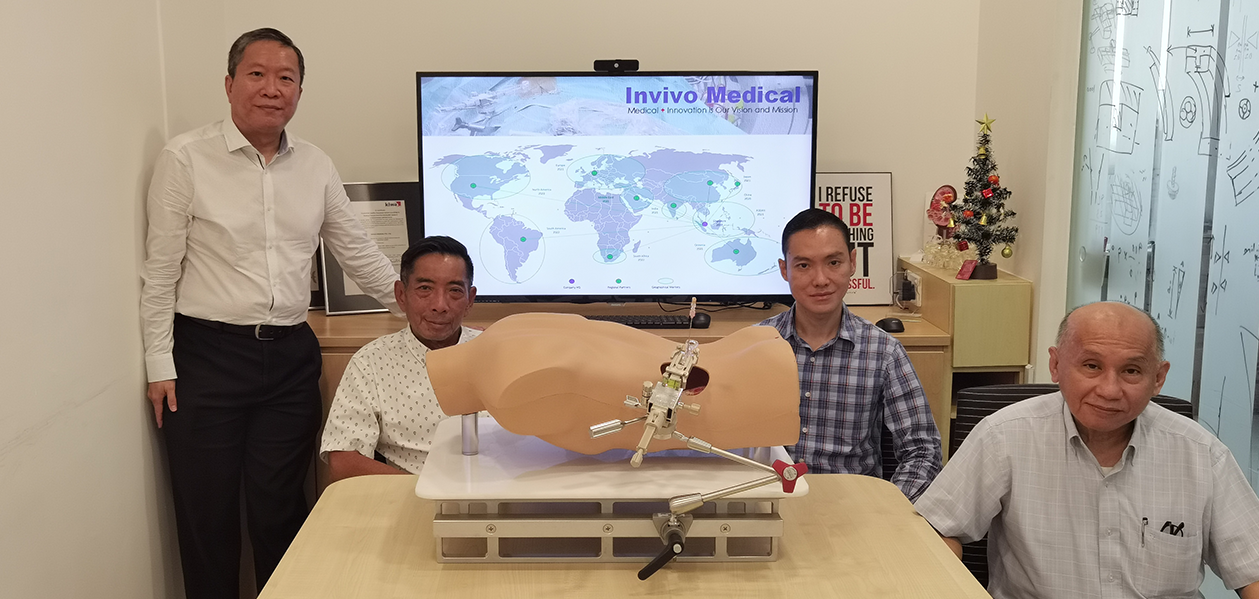Enhancing healthcare with open innovation
Safe, effective and affordable medical technologies can be brought to the market when the stakeholders across different disciplines successfully collaborate.
Set to overtake the European Union as the second largest market globally, Asia’s medical technology (medtech) sector was predicted to hit US$133 billion even before the COVID-19 pandemic struck. Reflecting its role at the heart of a thriving region, Singapore is home to over 60 multinational medical technology companies from global leaders to start-ups despite its relatively small population. One reason for Singapore’s attractiveness as a medtech hub is the quality of its institutions, from institutes of higher learning (IHLs) to hospitals and other healthcare providers.
Invivo Medical is a start-up formed in 2017 focused on minimally invasive surgeries, following the development of the Percutaneous Access to Kidney Assistive Device (PAKAD) between the Institute of Technical Education (ITE), National University Hospital (NUH) and National University of Singapore (NUS). For Dr Joseph Chai, director at Invivo Medical, the magic of medtech occurs when doctors, engineers and even regulatory experts can be brought together to collaborate and embrace open innovation.
1. What is the key challenge that Invivo Medical addresses and what is your value proposition?
Invivo Medical intends to improve the safety, efficacy and practicality of minimally invasive surgeries and biopsies. Our value proposition is the application of simple devices that deliver safe, effective, efficient and cost-effective treatment with minimally invasive procedures that directly benefit physicians and patients in modern healthcare. One such effort is the Percutaneous-Access-to-Kidney-Assist Device (PAKAD), that will help urologists in performing accurate, precise and efficient needle targeting when removing kidney stones.
2. How does Invivo Medical engage in open innovation?
With our first commercialisation project licensed from ITE, NUH and NUS, open innovation was part of Invivo Medical right from day one. We worked closely with several partners, taking the lead in operations, coordination, project management and decision-making. We worked very closely with the medical team at NUH and NUS on urology practices, and with the technology team from ITE’s Technology Development Centre on mechanical engineering and design. We also worked with our outsourced regulatory consultant to ensure that everything satisfied regulatory standards, and collaborated with many industry partners in different specialisations to identify the best technologies that would ensure the manufacturability of the innovation.
To drive collaboration and open innovation, Invivo Medical regards all parties involved in developing innovative ideas into usable products as partners in open innovation, including medical experts like physicians and surgeons, multi-disciplinary engineering team from IHLs and R&D institutions, manufacturing vendors, regulatory consultants as well as innovation agencies like IPI.
3. What are some lessons that you have learned in the process of engaging with open innovation?
It is natural for a medtech start-up to engage in open innovation due to limited resources and expertise—particularly for start-ups like Invivo Medical which focuses on both innovation and the commercialisation of medtech inventions.
We have also learned that open innovation is not only essential but critical for medtech ventures especially when it involves a start-up or SME. In the process of translating a medtech innovation into a commercial product, design or concept, iteration is common and specialised or deep medical knowledge is required. Further innovations are normally the result of joint efforts between a medical team and an engineering team, usually from an IHL or the industry. Such open and cross-disciplinary collaboration is natural and inherent to managing innovation in medtech ventures.
Another lesson we had was that open innovation in the medtech industry allows ideas and solutions from both physicians and engineers to be integrated into practical innovation that is reliable, effective and efficient for use.
4. How does Invivo Medical encourage a culture of open innovation?
We foster strong lasting relationships with open innovation partners by working closely with them through constant interaction and exchanges. We also encourage a culture within our organisation that recognises the importance of open innovation as a key success factor in a medtech venture.
5. What do you think hinders local SMEs and enterprises from engaging in open innovation and how can they overcome those obstacles?
In our experience, a large part of the challenges faced when managing open innovation is identical to challenges faced when coordinating projects, distributing resources, dealing with cultural differences and IP management in a multi-team setting.
Securing funding to support open innovation projects, especially when it is incremental, could also hinder organisations from embarking on them. It is also challenging for local SMEs and enterprises to strike a balance between commercial returns and providing the desired healthcare and social values in such scenarios.
Overcoming these obstacles requires partners in the commercial sector to work closely with one another while backed by strong support from the relevant authorities. Internally, enterprises must engage spirited and committed professionals to create a task force to manage fruitful open innovation collaborations with partnering organisations too.

